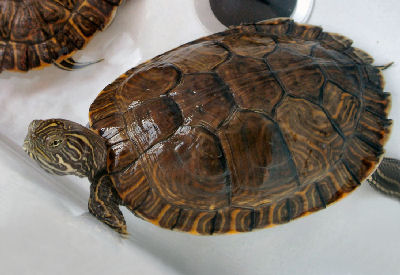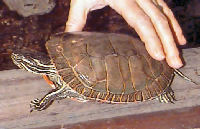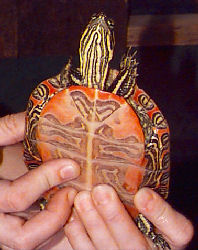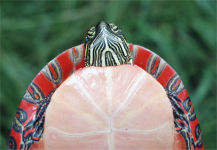 |
Painted TurtlesFamily: Emydidae
Latest Reader Comment - See More
The turtle pictured on the painted turtle page at the top is a common map turtle, not a painted turtle. Biologist Painted Turtles can can handle a wide variety of conditions and will become quite tame, making them wonderful pets!
Painted Turtle Contents
For more Information see: Selecting and Caring for Your Turtle or Tortoise
Distribution: Painted turtles are widespread throughout the United States from Canada to Mexico. Status These turtles are not listed on the IUCN Red List. Description: Painted turtles are some of the most beautiful turtles in the world and definitely in the United States. Depending on the subspecies, they have medium to dark green carapaces with amazingly fascinating peach to bright red plastrons with complex squiggles, swirls, and designs in black and pale yellow. Adult female painted turtles grow to 11" to 12" (13 to 15 cm) with adult males considerably smaller, usually 5" to 6". There are four subspecies of Painted Turtles:
In captivity most will also eat commercial turtle food and will eat large amounts of the aquatic plants found in their enclosures.They need a healthy and varied foods as they are prone to nutritional problems and shell defects when fed insufficient diets. Environment: Indoors: A basic setup with a large tub will be sufficient to hold three or four adult painted turtles. Add an efficient filtration system, a shop light fixture with UVB-emitting bulbs, and a basking spot with a 100-watt spotlight mounted above. For these sun-loving and warmth-loving turtles, you can add a 250-watt submersible heater to raise the water temperature a few extra degrees and maintain the water at 78 º to 82 º F (26 º to 28 º C).
The Painted Turtles do very well in outdoor ponds. In all but the coldest environments they are alert and active year-round. They are sun worshippers, so add plenty of branches and rock piles for them to climb out and bask. Also a lot of aquatic vegetation will keep these turtles happy. The northern specimens will hibernate, so care must be taken that they have a planned terrestrial hibernation site with piles of leaves, mulch, and hay. Southern Painted Turtles are less cold tolerant and will need to be taken inside during the winter. They may become so slow-moving that they drown if they are caught outside and get too cold in deeper water. Care must be taken that these, and any turtles, are not released into a wild habitat. The reasons are many. The introduction of non-native species can lead to the introduction of diseases and can lead to hybridization of introduced and native species. In addition, many turtles raised in captivity and released into wild situations are confused, unable to cope with extreme weather changes, and many surely fall prey quite quickly to the wary predators they may encounter. Handling: Captive-hatched specimens, as always, are the best to keep as pets and most will become so docile that they can easily be fed by hand. These and all aquatic turtles should be considered wonderful display animals and not pets that are easily held. Breeding: The captive breeding of Painted Turtles is simple and straightforward. Adults breed throughout the spring and a female can lay up to three clutches of 6-10 eggs each year. This species exhibits temperature dependent sex determination – eggs incubated at less than 81 ° F (27 ° C) produce males, 82 ° to 86 ° F (28 ° to 30 ° C) produce a mixed ratio, and above 86 ° F (30 ° C) produce females. Hatchlings thrive in a warm environment with clean, filtered water and live plants, both floating and submerged. They will feed on a wide variety of insects, insect larvae, and small fish in addition to commercial turtle food. Ailments / Health Problems: Not many, but shell and skin infections will arise in specimens kept in stagnant or dirty water. These and all turtles should be fed a varied diet consisting of thawed fish, worms, insects, plants, and commercial diets. Feeding only commercial turtle pellets will lead to obesity, fixation on a single food source, and even kidney stones, fatty livers, and other medical conditions leading to death. Ear abscesses occur from poor water quality and specimens kept in too cold conditions. Availability: Painted Turtles are readily available from better pet stores, breeders at the larger reptile shows across the country, and on-line. A new keeper should try to find specimens that are captive-hatched and at least six to eight months old to ensure the turtle has been feeding well and is well on its way with a strong start. They are usually inexpensive to purchase but one must realize that the expenses of setting up a proper environment are considerable.
[Home] [Newsfeed] [Saltwater Aquariums] [Reef Aquariums] [Freshwater Aquariums] [Pet Cats!] [Pet Dogs!][Pet Birds] [Small Animals] [Reptiles] [Cute Pets] [References] [Team] [Pet Links] [Pet Supplies] [Care Sheets] [About Animal-World] [Site Map] [Privacy Policy] [Recommended Pet Books] [Cat Care] [Dog Care] [Fish Care] [Bird Care] [Reptile Care] [Reptile Information] [Bird Information] [Types of Pets] [Types of Dogs] [Types of Cats] [Pictures of Pets] [Pictures of Animals] [Exotic Pets] [Gold Fish Care] [Fresh Water Fish Care] [Salt Water Fish Care] [Tropical Fish Care]
[French] [German] [Japanese] [Portuguese] [Spanish] [Russian] [Simplified Chinese] [Traditional Chinese] | |
|||||||||||||||||||||||||||||||||||||||||||||||||||||||||||||||||||||||||||||||||||||||
Copyright © [Animal-World] 1998-2009. All rights reserved.







 Pet Videos!
Pet Videos!













